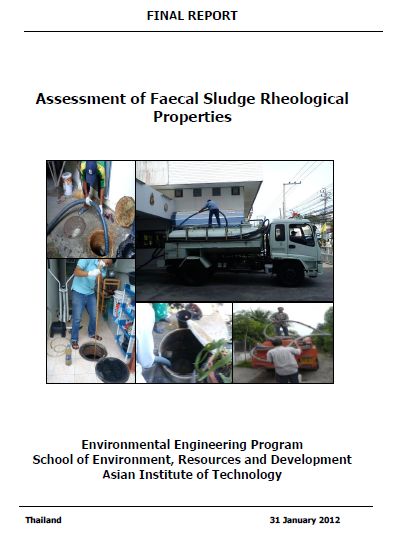Assessment of Faecal Sludge Rheological Properties - Final report
Koottatep, T., Surinkul, N., Paochaiyangyuen, R., Suebsao, W., Sherpa, M., Liangwannaphorn, C., Panuwatvanich, A. (2012)

Published in: 2012
Publisher:
Environmental Engineering Program, School of Environment, Resources and Development Asian Institute of Technology, Thailand
Author:
Koottatep, T., Surinkul, N., Paochaiyangyuen, R., Suebsao, W., Sherpa, M., Liangwannaphorn, C., Panuwatvanich, A.
Uploaded by:
SuSanA secretariat
Partner profile:
Asian Institute of Technology
5927 Views
207 Downloads
Content - Summary
This study focused on onsite sanitation systems treating black water which collected from 4 types of sanitation system such as septic tank system, one cesspool system, two cesspools in series system and commercial treatment system. This study presents sanitation information, rheological, physical, chemical properties, desludging equipments, routing and GIS map, and management practices of each area.
Based on sanitation interviews, majority of households lacks of information concerning sanitation system expenses. Since the houses are rented or septic tanks were constructed at the same time of building house. Average number of toilet is 1-2 rooms per household. Mostly use flushing system in Nonthaburi and Nakhon Ratchasima, both flushing and pouring system in Lampang and pouring system in Suan Pheung Ratchaburi.
Based on field observation of onsite treatment system configuration demonstrated that total volume of onsite systems in Thailand such as septic tank, one cesspool, two cesspools in series and commercial septic tank were range of 0.4 – 6.3 m3/ household which the average of 1.48, 1.42, 1.35 and 1.42 m3, respectively. The variation of total volume probably was due to type of onsite treatment system and location of the community. Considering sludge accumulation rate illustrated that one cesspool present the highest of average accumulation rate which about 300 L/cap/year while the other system shown about 135 – 180 L/cap/year.
Samples were collected from two parts, wet fluidized sludge and wet bottom sludge. Dried sample was developed from wet bottom sample. Results indicate that the maximum density of wet bottom sludge were not significantly different among different studied areas which ranged between 1.0923-1.1585 g/cm3. The average viscosity from septic tank system, one cesspool system, two cesspools in series system and commercial system were presented about 25.3, 52.4, 77.7 and 77.6 cP, respectively.
For physical and chemical properties, they are illustrated that concentrations of bottom sludge were higher than fluidized sludge about 1.5 – 5 times for almost parameters. Therefore TS concentrations of fluidized sludge were ranged from 830 – 288,840 mg/L whereas concentrations from bottom sludge were ranged from 2,160 – 188,480 mg/L. COD concentrations of fluidized sludge were ranged from 3,290 – 33,090 mg/L whereas concentrations from bottom sludge were ranged from 5,710 – 125,660 mg/L. On the other hand the conductivity and water content from fluidized sludge and bottom sludge were not significantly different which presented about 1.9 and 2.0 ms/cm for conductivity and 33% and 32% for water content, respectively. The %TC and %TN in dried sludge, were between 14.36 – 47.65 and 1.03 – 6.94, respectively. Dried sample of 6.42 mg was tested at temperatures between 25 to 100 oC, the specific heat values were between 1.67 to 5.45 J/g oC. The composition of dried FS found are depended on each source which can be sorted out into sludge, plastic, sand, debris especially seed of paprika, and human hair.
Bibliographic information
Koottatep, T., Surinkul, N., Paochaiyangyuen, R., Suebsao, W., Sherpa, M., Liangwannaphorn, C., Panuwatvanich, A. (2012). Assessment of Faecal Sludge Rheological Properties - Final report. Environmental Engineering Program, School of Environment, Resources and Development Asian Institute of Technology, Thailand
Filter tags
East Asia & Pacific English Faecal sludge treatment processes Fundamental research and engineering Urban (entire city)















